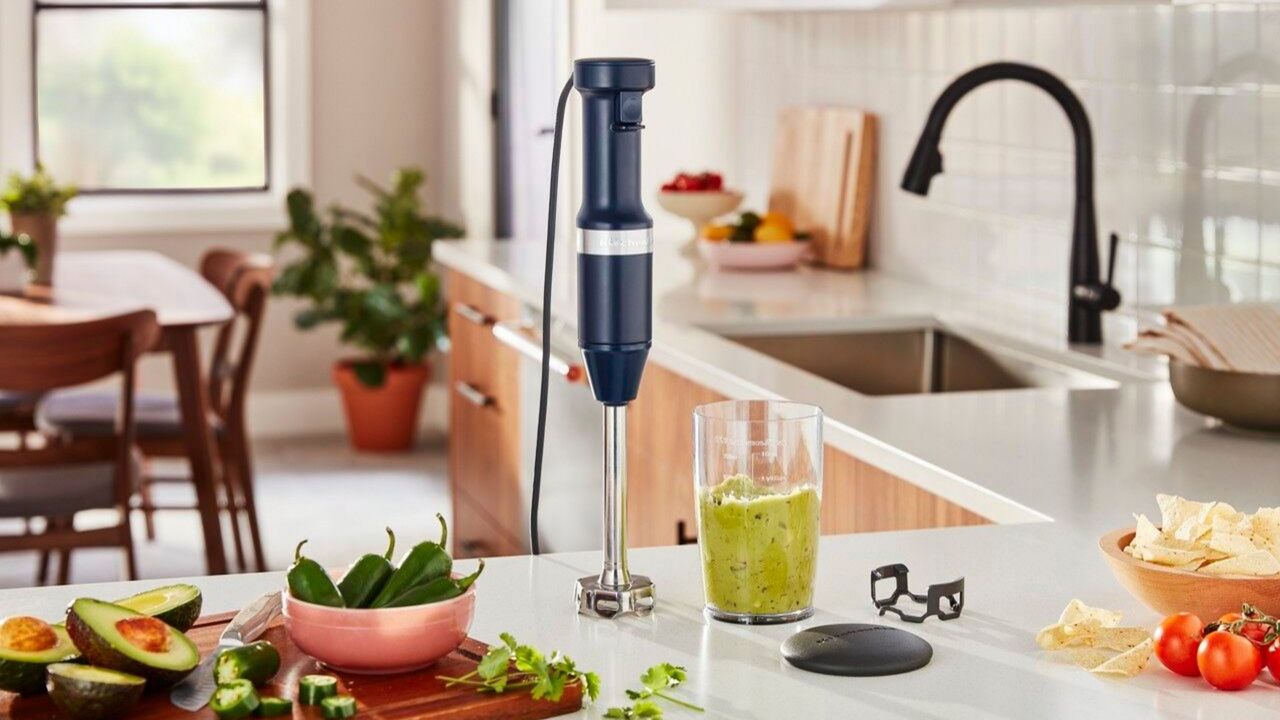What can an immersion blender make – and should you buy one?
Wondering what to make with an immersion blender and if it's something you should buy? We take an honest look at what an immersion blender is, what it can do – and its limitations


Wondering what an immersion blender is and what you can make with one? There may be a whole lot more you can do with one of these stick blenders than you first supposed. Lightweight and easy to use, an immersion blender can be a super versatile part of your collection of kitchen appliances and, in our opinion, no kitchen should be without one.
You may already know that you can make fabulous fresh soup with an immersion blender but may be wondering just how you should go about it. You might also be considering if it’s the appliance to use for creating smoothies. And what about using it for tasks such as whipping cream, crushing and blending ice, crushing frozen fruit, and frothing milk? Is it the appliance for the job when these are on the agenda?
Here, we take a look at which kitchen tasks you can use the best immersion blenders for.
What can I use an immersion blender for?
Unlike traditional countertop blenders, which have their own jug or jar, an immersion blender is a hand held blender that you dip it into a deep bowl or pan to do the mixing.
They can do many of the jobs a traditional blender can, from making fresh soups to salad dressings, but you will need to buy carefully if you want to do more.
‘For some tasks you might want to undertake with an immersion blender, you’ll need a model with attachments,’ explains Lucy Searle, global editor in chief of Homes & Gardens. ‘Our best immersion blenders guide lets you know whether a particular model has attachments and we detail this within our individual immersion blender reviews, too.’
This is the lowdown on what to make with an immersion blender with information on which tasks need an attachment.
How to use an immersion blender for soup
An immersion blender is ideal for making soup at home as you can use it in the pan on the stovetop, avoiding the need to move hot ingredients from pan to a blender container.
The way you should use an immersion blender for soup depends on the desired texture. You might want to purée the soup for a smooth result, or you may be making a soup that’s best with chunks of veggies left in the mix.
To use an immersion blender for soup, insert the blender so the blades are below the surface of the liquid. Start blending at a lower speed, then increase it as necessary. If you’re puréeing the soup, angle the blender slightly and slowly move the blades around the pan.
Want to leave some tasty chunks of vegetables in the soup? Again, use the blender at a slight angle. Keep the blades in one place for a couple of seconds, then move them to another part of the mixture and repeat. Working in small areas allows you to blend most of the mixture but leave some larger pieces of the vegetables in the soup.
Always ensure the blender head is full immersed in to the ingredients to avoid spatter.
Can an immersion blender make smoothies?
An immersion blender is ideal for making smoothies as it can be used directly in the glass or container from which you’ll drink your fresh concoction. An immersion blender will cope with veggies or fruit, so you can make a whole host of different recipes.
‘Be careful not to overfill the container if you’re making a smoothie,’ cautions Homes & Gardens’ Reviews Editor Millie Fender. ‘Put the fruit and/or veggies in first (think 1 inch cubes) then add water, milk or an alternative liquid, plus anything else you want in the mix – perhaps nuts or seeds.’
Move the blades up and down in the container as you blend so they work on all the ingredients.
Of course, if your immersion blender comes with a blender jar, you can use this instead of blending directly in the container. Follow the same process, then decant the smoothie into a glass for drinking.
Add ice cream and milk, and you can also make milkshake in a blender.
Can an immersion blender whip cream?
An immersion blender can whip cream – but you’ll have to invest in one that comes with a whisk attachment in order to aerate the cream. Try it with the regular blades and it’s difficult to avoid spatter or ending up with a grainy consistency. An immersion blender without an attachment isn’t designed for the task of whipping cream, so use it for the jobs it excels at such as puréeing soups and employ a different method for whipping cream.
Can an immersion blender crush ice?
Typically, you can’t use an immersion blender to crush ice as this can cause damage to its blades. This isn’t always the case, however. For example, the Braun MultiQuick 9 Hand Blender MQ9199XL, which we awarded five stars in our review, has an ice crush knife among its attachments.
‘If you want your immersion blender to crush ice, always opt for a model that lists this among its features,’ says Lucy Searle. ‘Otherwise, at worse, you’ll harm the blades and invalidate the warranty.’
Can an immersion blender crush frozen fruit?
Some immersion blenders can crush frozen fruit but, as this isn’t always the case, be sure that the model you choose specifies it can be used for this task to avoid harm to the blades.
If your model isn’t suitable for the job, thaw the frozen fruits you need for the recipe in the refrigerator beforehand to ensure the immersion blender can work effectively and turn them into a purée.
Can an immersion blender blend ice?
An immersion blender isn’t typically the right appliance for blending ice. However, do check the features of your immersion blender to see if it’s a task the manufacturer says it’s specified for.
The potential problem with blending ice with an immersion blender? It can damage the blades, so be sure the model in which you’re interested promises it can undertake the task before buying if blending ice with the appliance is a must for you.
Can an immersion blender froth milk?
An immersion blender can froth milk for a coffee or hot chocolate. ‘Just like when you’re making a smoothie, pay attention to the large volume of frothed milk you will create when you use the immersion blender,’ says Millie Fender, Reviews Editor of Homes & Gardens. ‘Use a generous container and half fill it with milk.’
To froth the milk without mess, be sure to put the immersion blender blades below the surface of the milk and begin at a lower speed, increasing it only as required.
Can I mash potatoes with an immersion blender?
You might be able to mash potatoes with an immersion blender, depending on the model. If this is one of the kitchen tasks you want to use your immersion blender for, look out for a model with a special mashing attachment.
When we tested the Braun MultiQuick 9 Hand Blender MQ9199XL, which does have a masher attachment, we found it was essential to peel the potatoes fully to avoid jams.
What can't you do with an immersion blender?
Immersion blenders are best for small serve recipes, such as vinaigrettes, smoothies and soups. They're also good at working the lumps out of sauces you've hand-cut ingredients for. Anything larger than an inch-sized chunk they will struggle with. Not all can cope with frozen foods and ice, so do check carefully before you buy.
Can I use an immersion blender for mashed potatoes?
Never try to mash potatoes with an immersion blender, or any blender, in fact. The result will be gloopy, slimy and unpleasant.
Immersion blender vs blender: which to buy?
Whether you choose an immersion blender or blender really depends on what you cook and how often. If you regularly make smoothies, soup and more, a traditional countertop blender that sits on a base will suit you more. They are more powerful, can mix batches more quickly and leave you hands-free, to a degree.
An immersion blender is better for those quick mix jobs or single serves, plus they're a little easier to clean afterwards, since cleaning a blender typically means cleaning more parts.
That said, if you have the space, we'd advise getting both.
Where to buy immersion blenders
Below, we've listed our favorite stores for getting great immersion blenders; our pricing widget below also updates constantly so you can grab the best deal of the day for both immersion and countertop blenders.
Sign up to the Homes & Gardens newsletter
Design expertise in your inbox – from inspiring decorating ideas and beautiful celebrity homes to practical gardening advice and shopping round-ups.

Sarah is a freelance journalist and editor. Previously executive editor of Ideal Home, she’s specialized in interiors, property and gardens for over 20 years, and covers interior design, house design, gardens, and cleaning and organizing a home for Homes & Gardens. She’s written for websites, including Houzz, Channel 4’s flagship website, 4Homes, and Future’s T3; national newspapers, including The Guardian; and magazines including Future’s Country Homes & Interiors, Homebuilding & Renovating, Period Living, and Style at Home, as well as House Beautiful, Good Homes, Grand Designs, Homes & Antiques, LandLove and The English Home among others. It’s no big surprise that she likes to put what she writes about into practice, and is a serial house renovator.
-
 What does it mean to 'harden off a plant'? Experts explain this gardening term – and why it's important
What does it mean to 'harden off a plant'? Experts explain this gardening term – and why it's importantIf you've started seeds indoors, 'hardening off' is a key step when moving them outside
By Holly Crossley Published
-
 7 things you should repair instead of replace in your home – and how to complete the job well yourself in a few simple steps
7 things you should repair instead of replace in your home – and how to complete the job well yourself in a few simple stepsEasy steps for fixing common household items
By Eve Smallman Published